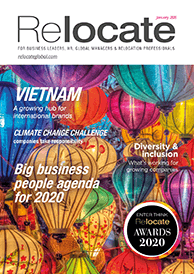People analytics data – what is its value to HR professionals?
Dr Sue Shortland reports on the recent CIPD people analytics conference ‘Are you prepared for the future of people data?’ and looks at how people data can help businesses.

Click on the cover to access the digital edition and order your printed copy.
The CIPD (Chartered Institute of Personnel and Development) is placing considerable emphasis on people analytics data and how it can help to advance evidence-based decision-making by HR professionals within organisations. At its recent people analytics conference ‘Are you prepared for the future of people data?’, the HR professional body drew attention to building a data-driven culture and its inherent benefits, illustrated with numerous case study examples from major businesses and public sector bodies. The conference opened with a call from the CIPD for HR to take up the challenge to use data to help build capability and skills. For those beginning their careers in HR, the CIPD emphasised the potential career opportunities that a strong focus on people analytics can bring. People analytics is predicted to become a standalone function within HR, with various roles available within data analysis and communication leading on to high-level positions such as head of people analytics. Data-driven organisations will offer clearly defined HR career pathways. Notwithstanding this, the first challenge identified at the conference was how to change organisational culture to become data-driven.
Driving forward a people analytics data culture
To achieve a data-driven approach to decision-making, the value of people analytics data must first be recognised, including how added business value can be derived from using data, scaled up for implementation across the business and embedded within organisational cultural values. To establish new mind-sets and behaviours, old habits need to be broken to prevent people from using previous decision-making processes. The first step to achieve this is to develop awareness by being explicit about the value of data and communicating clearly how it can be used. Continuous feedback is needed to ensure that people keep on using data in their decisions. Facilitating the use of data in decision-making will require guidance on the decisions needed, development of data literacy and the input of fresh capability to prepare data. HR itself needs to become data literate if it is to assist others in this process. Changing the environment so that systems and workspaces encourage data sharing and discussion will help to embed the new data-driven culture. In addition, key performance indicators linked to data usage can help to reinforce the culture. People analytics data can enhance business success in a variety of ways, for example, in driving forward improved knowledge sharing, workforce planning and improving employee engagement.Learning and development
The development of a smart data-driven learning and development platform can assist businesses to improve knowledge capability. By recording how, when and where learners access learning materials – and the information they find most useful – learning and development interventions can be better tailored to the needs of the business and the users of the learning materials who are required to deliver business objectives. Business questions linked to organisational strategy can be identified through data capture and then these questions addressed via the development and posting online of the most relevant sources of knowledge. Analysis of usage data can show which sources of knowledge are most used/helpful. The curation of learning and development materials can then be tailored to ensure the most appropriate catalogue of relevant topics are easily accessible to staff.Diversity and inclusion
A further example concerns the use of people analytics data to make meaningful change around diversity and inclusion. Understanding and appropriate storytelling of data can be used to make links between numbers (such as headcounts) and projecting forward as to what a workforce profile will look like in the future. By analysing the data evidence of a current workforce profile and recruitment and selection metrics, strategies can be devised and enacted to hire, promote and retain a more diverse workforce. In this way, people analytics dashboard data is brought to life with strategic actions taken to create a dynamic workforce profile. Hence, the connection of data to business outcomes helps build momentum for change.Download our free Global Mobility Toolkit factsheets - on diversity, group moves, talent and career management, and many more topics
Workforce planning
Data analytics can also be used for workforce planning to ensure the right people with the right skills are in place at the right time and cost. Using people data analytics can assist in identifying and recording the skills currently held in a business and matching them to skills required in future operations. Data must be accurate and high quality to ensure that in redeployment exercises, people are treated objectively and fairly. Using data analytics to identify people and their appropriate future job roles is, of course, unlikely to lead to a 100 per cent match between current skills and future capability requirements. Nonetheless, it can help to identify the main skills available and slot people into potential roles. It can also identify gaps and training needs. A factor that also needs to be considered is location – a people-job match may involve relocation and that may not always be the best solution for the individual or the business.Related articles
- HR sidelined in AI investment decisions and implementation
- Why digital transformation creates a retention problem for certain types of employees
- UK scheme to retrain workers ousted by AI
Employee experience
Organisations wishing to measure and improve their employee experience can also make use of people analytics data to aid this process. Data from engagement surveys and exit interviews, for example, can be used to assess employee values and how these align with organisational values and priorities. If an organisation plans a culture-change journey, data analytics can be used to map out where the current priorities lie and how these will need to change to reach the desired endpoint.Keep up-to-date on HR news and features in our dedicated HR section.
Line managers are key to cultural change and so they need to understand the data and the steps needed to move to a new cultural environment. Regular pulse checks on how employees feel about the change process can generate data, which can be used to consolidate wins as the journey progresses and address problems through change champions.
Top tips
One of the key messages of the conference was not to rely on ‘shiny’ charts and graphs. Data comes to life through storytelling with the creation of a narrative around the aims and objectives of organisational change. Data champions – people who understand data and enjoy communicating its messages – at all levels in organisations are crucial to embedding a data-driven culture. The importance of starting small and growing a people analytics culture was also stressed. To assist HR practitioners in their data journey, ISO standards are being developed (ISO 30414) with principles being articulated that capture emerging excellent practice in context. The new book Human Capital Management Standards: A Complete Guide by CIPD staff Wilson Wong, Valerie Anderson and Heather Bond (published in 2019 by Kogan Page) should also prove helpful.Finally, the CIPD reminds us that it is always important to maintain a responsible and ethical approach to data collection, analysis and dissemination. Working within legislative guidelines, the message is to only collect data that you need and be sure to think about its limitations when using it to drive change forward.Read more articles in the Winter Issue of Relocate Magazine.
Subscribe to Relocate Extra, our monthly newsletter, to get all the latest international assignments and global mobility news.Relocate’s new Global Mobility Toolkit provides free information, practical advice and support for HR, global mobility managers and global teams operating overseas. Access hundreds of global services and suppliers in our Online Directory
Access hundreds of global services and suppliers in our Online Directory
©2025 Re:locate magazine, published by Profile Locations, Spray Hill, Hastings Road, Lamberhurst, Kent TN3 8JB. All rights reserved. This publication (or any part thereof) may not be reproduced in any form without the prior written permission of Profile Locations. Profile Locations accepts no liability for the accuracy of the contents or any opinions expressed herein.







































